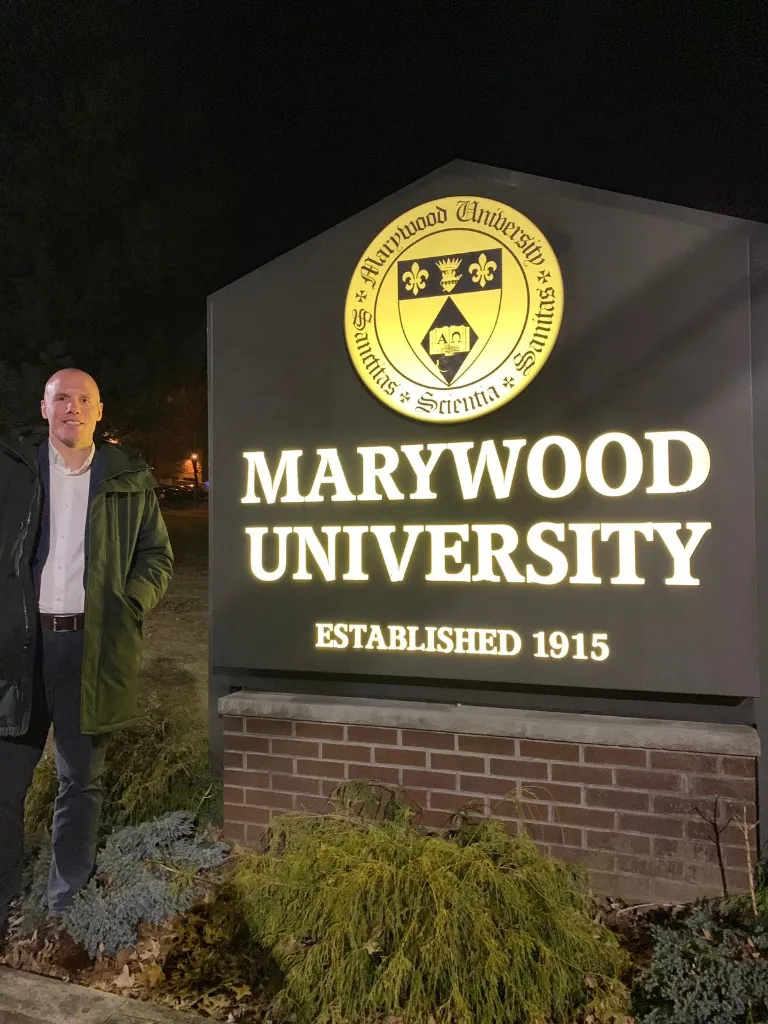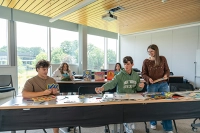
Marywood University and Sunday in Harlem
Published
After the whistle stop tour of Niagara falls and the brief jaunt over the border into Toronto, it was back in the hire car on Sunday morning to head down the freeway to Scranton, Pennsylvania. Our destination: Marywood University.
The Institute of International Education are the US body who manage the Fulbright program on this side of the pond. They operate a scheme called the ‘Outreach Lecturing Fund’. The OLF is intended to give scholars the opportunity to lecture in other parts of the country, beyond the host institution where they are based. Specifically, the OLF seeks to match scholars with universities who wouldn’t necessarily otherwise have the opportunity to host Fulbrights or who perhaps haven’t produced many of their own Fulbright participants over the years. So this isn’t about visiting Harvard, Princeton or Yale; it is about identifying regional universities who would benefit from exposure to the Fulbright program.
Fortunately for me, I received an email from Marywood University about a month ago. They were looking for a criminal justice scholar to come and deliver a couple of lectures to their CJ students. Scranton is a great little city. It is Pennsylvania’s 5th largest, after Philadelphia, Pittsburgh, Allentown and Erie. It is located in the Lackawanna River valley, within Lackawanna County. Coal mining was the formative industry for the city and in the 1930s the population reached more than 140,000. Scranton established a reputation as the “Electric City” when electric lights were introduced in 1880 at Dickson Locomotive Works. Six years later, the nation’s first streetcars (trams) powered exclusively by electricity began operating in the city. Post WW2, the mining industry declined and with it the population, which is now about 77,000.
Marywood is a Catholic liberal arts university, with circa 3000 students. It is set in immaculate grounds in a beautiful campus, in a residential area a couple of miles north of downtown. It has undergone extensive redevelopment in recent years, with an impressive new library being built and a thriving centre for architecture, occupying an old sports hall and swimming pool building. This is now regarded as one of the best centres for architectural study in the US.
Our lodgings were in a hotel in the centre of the city, in what was an old railway station. A great building, full of character (and the french toast wasn’t bad either).
I met the faculty team on Monday morning and enjoyed an early lunch in the university canteen. I then delivered a lecture to Dr Jeff Clutter’s undergraduate class. I gave some background to UK policing, the kind of stuff the Met is focusing on in London and then we worked through some case studies re police use of force. With lots of good questions coming from the class, they seemed pretty engaged and interested in what I had to say. After a tour of the campus, I was invited to an informal reception to welcome me to the university. Cheese, crackers and fresh fruit were served in the library, overlooking the campus and I enjoyed meeting a number of academics and staff from across the university.
I spent an hour or so chatting with Jeff and Dr Alex Vari, who is the Fulbright coordinator at the University. It was then on to the second lecture of the day, this time to a larger group: students, staff, academics and some local police chiefs who had been invited to come along. My talk was entitled: Legitimacy, Leadership and Trust: Policing Perspectives from the UK. It seemed to be well received and I enjoyed answering some questions from the audience afterwards.
It was then onto dinner downtown with Jeff (who must have been getting sick of me by now, but I really enjoyed his company) and Dr Hannarae Lee, who is one of the other CJ academics at Marywood. Hanna has a fascinating background, having moved to the US from Korea in her late teens, she went through the US university system and had some interesting perspectives on life in the east versus the west, so conversation over dinner was great.
The plan had been to have a further couple of meetings at Marywood on the Tuesday morning, but with heavy snow forecast, a pre-emptive ‘snow day’ was declared by the university; so early on Tuesday morning we got in the car and headed back to NYC. It was a treacherous drive, but the roads just about remained passable. What should have taken just over 2 hours took nearly 5 – but it was a great adventure and seeing rural Pennsylvania covered in snow was pretty spectacular.
On Tuesday evening, as I was on my way home from yoga, news began to come through about an incident in Queens. All the local news websites were reporting events as they unfolded, trying to filter through the facts versus the speculation. Just before 10pm, the Mayor and the Police Commissioner held a press conference from Jamaica Hospital: Detective Brian Simonsen (42 years old) had been shot and killed at the scene of an armed robbery.
The suspect was shot 8 times, but survived. He had an imitation firearm.
Simonsen had been shot by one of his colleagues, in a devastating case of friendly fire.
Another officer, Sergeant Matthew Gorman, was also shot in the leg, by a stray bullet from a police firearm.
Flags are flying at half mast across the city. This tragic set of circumstances has clearly been very difficult for the NYPD.
Whilst emotions are understandably still running high, a number of searching questions are also being asked – particularly in relation to tactics and training. We now know that 7 officers fired 42 rounds over the course of 11 seconds.
In 2009, a colleague at John Jay contributed to a state review of police ‘friendly fire’ incidents. Between 1981 and 2009, 26 cops had been shot and killed by friendly fire across the US. Ten years later, these kind of incidents are still happening, with a number of the recommendations of a decade ago yet to be implemented with any real success.
I’m no expert in police use of firearms (far from it) but it is apparent that there are difficulties in the US in relation to tactics and training – and brave police officers are losing their lives as a result. Police departments across the country will need to reflect critically on what steps can be taken to resolve this.
To conclude the week…
On Sunday morning, we were collected bright and early by Dr Frank Pezzella and his wife Patricia. Frank, a colleague from the university, grew up in Harlem and kindly offered to take us on a trip around his old neighbourhood, to get a bit of a history lesson and then head to the Abyssinian Baptist Church. We had an absolutely brilliant time. The people we are meeting on this trip are fantastic and are certainly making it a great the best experience it can be. The day with Frank and Patricia was no exception. We were made to feel incredibly welcome by everyone we met.
Dr Calvin Butts has been at the Abyssinian Baptist Church for the best part of 50 years, most of that as pastor, leading a sizeable African-American congregation. Being Black History Month (known as African-American History Month in the US), much of his sermon considered the history of race relations and civil rights in the US and the oppression that black Americans have been subjected to over the years. The Church has a stated intention to involve itself in contemporary social issues and address difficult social conversations. I certainly found this much more stimulating than the more traditional sermons I have encountered in the UK.
Music was a huge part of the service and was absolutely amazing. A gospel choir with more energy and talent than you can possibly imagine. They really were amazing.
After the service, we continued our tour of Harlem, seeing where Frank went to school and where he lived during his teens. We saw a hotel where Fidel Castro stayed in the 1960s and observed the street corners and churches where Martin Luther King used to preach to the people of Harlem. We also found out that the Schomburg Centre for Research in Black Culture is just a few blocks north of where we are staying, a division of the New York Public Library.
We then headed for brunch at “Londel’s” – an ex NYPD cop who owns this authentic Harlem eatery. We were shown through to Londel’s office and saw some great pictures, including one of him with John Lennon! Londel was the perfect host and made us feel very welcome as we tucked into chicken, salad, warm rolls and mimosas.
With a visit to see ‘Jersey Boys’ on Broadway and a cliché (but fun) session ice skating opposite Brooklyn Bridge, it has been a very busy and very enjoyable week…
Until next time… NYC in the sunshine….
-
 AIA Pennsylvania Honors School of Architecture with 2025 Social Impact Award
AIA Pennsylvania Honors School of Architecture with 2025 Social Impact AwardThis honor is part of the AIA Pennsylvania Architectural Excellence Special Awards program, which recognizes outstanding contributions by individuals, organizations, and institutions that advance the built environment and the architectural profession across the Commonwealth.
-
 Marywood University’s John Maurer to Perform National Anthem at Boston Celtics Game
Marywood University’s John Maurer to Perform National Anthem at Boston Celtics GameJohn Maurer to perform the national anthem at the Boston Celtics game in January
-
 How to Become a Teacher at Marywood University
How to Become a Teacher at Marywood UniversityExplore Marywood’s Education programs and learn how strong preparation, real classroom experience, and clear certification guidance set future teachers up for success.